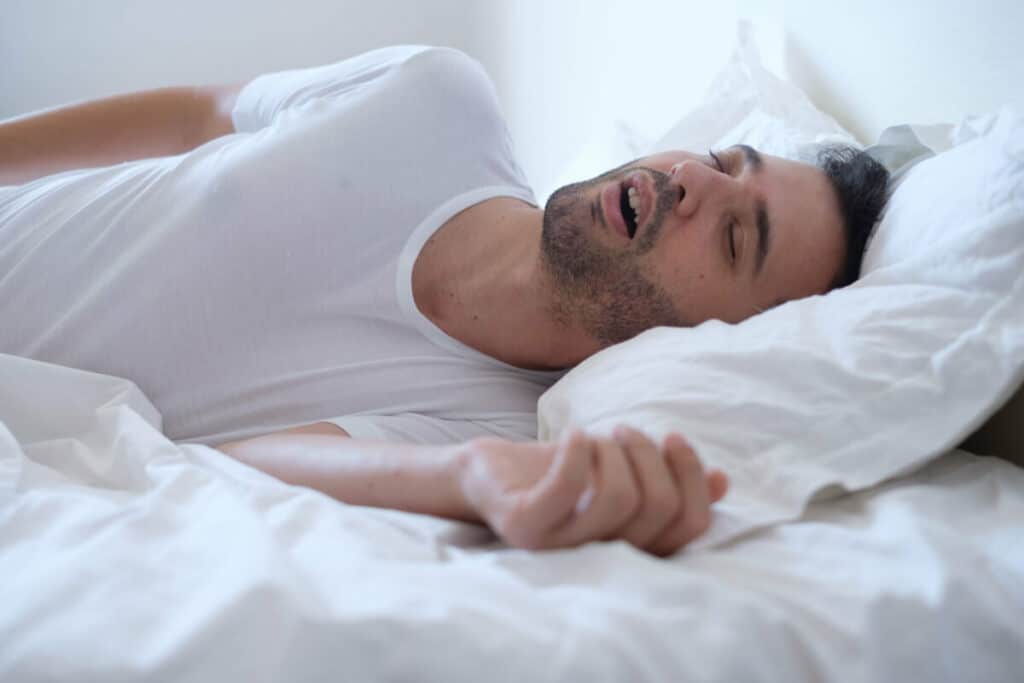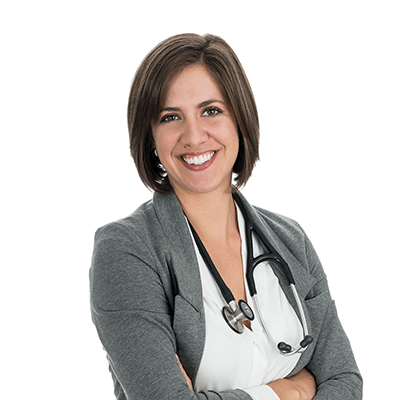Sleep apnea is a common breathing disorder that occurs when airflow is significantly reduced or completely stops periodically during sleep. Various factors can influence the onset of this sleep disorder, including having a larger tongue or excess fatty tissue. (20) Sleep apnea can cause poor sleep quality and lower blood oxygen levels. (19) If left untreated, sleep apnea can lead to serious health complications, including heart disease and poor memory. (20)
Although medical intervention is often necessary to treat sleep apnea, various non-invasive natural remedies can help relieve symptoms of sleep apnea, including lifestyle changes and sleeping position.
Keep reading below to learn more about addressing and treating sleep apnea naturally.
What is sleep apnea?
There are two types of sleep apnea: obstructive sleep apnea and central sleep apnea. Obstructive sleep apnea is one of the most common sleep disorders, while central sleep apnea is uncommon in the general population. (16) Some individuals may develop both types of sleep apnea, called mixed sleep apnea. (20)
Central sleep apnea
In central sleep apnea, signals between the brain and the muscles that control breathing are disrupted, causing pauses in breathing. (16) This can be related to various factors, including:
- Cheyne-Stokes breathing (a rare abnormal breathing pattern)
- Continuous positive airway pressure (CPAP) machine use
- High altitude
- Narcotic medication use
- Obesity hypoventilation syndrome (an obesity-related breathing disorder) (5)
Central sleep apnea may also develop without a known cause, referred to as idiopathic central sleep apnea. (17)
Obstructive sleep apnea
Obstructive sleep apnea syndrome is a common condition caused by a physical airflow blockage, such as having:
- A larger tongue
- A small upper airway or smaller jaw
- Large tonsils
- Overweight or obesity (20)
During sleep, the tongue and throat muscles relax slightly more than while awake. Obstructive sleep apnea can cause the walls of your throat to collapse and narrow or become blocked by the tongue or tonsils. As air travels through this narrow passage, it causes throat tissues to vibrate, also known as snoring. When the airway is blocked, your brain signals you to breathe, and you may subconsciously wake up coughing or gasping for air (arousal response). (16)(21)
Did you know? Most sleep apnea patients aren’t aware their sleep was disrupted, but for patients with severe sleep apnea, sleep interruptions may happen hundreds of times per night. (21)

Sleep apnea symptoms and risk factors
Daytime sleepiness or restlessness can be early signs of sleep apnea. Chronic snoring (louder than talking normally), dry mouth, headaches, and a decreased libido (sexual drive) may occur. (14) Sleep apnea can occur at any age due to lifestyle or genetic factors. There are many risk factors for developing sleep apnea, including:
- Alcohol and tobacco use, which can impact the muscles of the mouth and upper airway, as well as brain signaling during sleep
- Being 50 years old or older, which can affect brain signaling and increase fatty tissue buildup in the neck and tongue
- Hormonal changes, which can affect the size and shape of your airway, face, or tongue
- Family history of sleep apnea or related health conditions (e.g., cleft lip/palate, hypoventilation syndrome)
- Genetic factors that influence the shape of your skull, as well as how your brain controls breathing during sleep
- Heart or kidney failure, which can cause fluid buildup in the neck and obstruct the upper airway
- Opioid medication use, which can alter brain function during sleep
- Overweight or obesity, which can cause excess fat to deposit in the neck, shrinking the upper airway (12)
Sleep apnea precautions
Contact your healthcare provider if you think you may be experiencing sleep apnea. Depending on your unique symptoms and risk factors, a sleep study may be required to diagnose the condition. Untreated sleep apnea can cause severe daytime fatigue, which can affect concentration, memory, decision-making, and motor skills. Sleep apnea may also increase the risk of certain health conditions, including:
- Asthma
- Certain cancers (e.g., pancreatic, renal, skin)
- Chronic kidney disease
- Eye problems (e.g., glaucoma, dry eye)
- Heart and cardiovascular diseases (e.g., high blood pressure, heart attacks, heart failure, stroke)
- Metabolic syndrome (a group of metabolic disorders)
- Pregnancy complications
- Type 2 diabetes (13)
Natural remedies for sleep apnea
Medical treatment options for obstructive sleep apnea depend on the underlying cause, but can include breathing devices, oral appliances, or use of a CPAP machine. Treating central sleep apnea often involves addressing the underlying health condition. (15)
Several lifestyle factors can worsen sleep apnea, such as drinking alcohol and having excess fatty tissue. Adopting healthy lifestyle habits, such as maintaining a healthy weight and adopting a side sleeping position, can help reduce sleep apnea symptoms and promote better sleep. (10)
1. Avoid alcohol
Drinking alcohol can increase the frequency and duration of sleep apnea episodes, especially when consumed just before bedtime. Going to sleep after drinking alcohol can:
- Negatively affect the sleep cycle
- Relax throat muscles more than usual, causing upper airway collapse
- Slow the brain’s arousal response when breathing stops (10)
Heavy drinkers, defined by the Centers for Disease Control and Prevention (CDC) as 15 or more drinks for males and eight or more drinks for females per week, are at the greatest risk for severe sleep apnea, while light- or non-drinkers are more likely to experience mild sleep apnea. (18)
Avoiding alcohol can help promote better sleep and decrease snoring and the severity of sleep apnea. (10) To learn more about reducing alcohol intake, consult with your healthcare provider.

2. Incorporate breathing and throat exercises
Orofacial therapy (face, mouth, and throat exercises) and other airway training (e.g., singing, instrument playing) may help alleviate obstructive sleep apnea symptoms by strengthening the muscles that control the upper airway, tongue, and face. (15) Examples of orofacial and breathing exercises include:
- Breathing in deeply through the nose then forcing the air out through the mouth into a balloon
- Placing the tip of the tongue against the back of your teeth, then sliding the tip back (toward your throat) against the roof of your mouth
- Pressing the tongue against the roof of your mouth
- Pronouncing or singing vowels (a, e, i, o)
- Sucking in cheeks (buccinator muscles) with closed lips (6)
A combination of orofacial and breathing exercises should be completed daily, sometimes several times throughout the day. Regularly performing various orofacial and breathing exercises may reduce snoring and self-perceived daytime sleepiness. (2)(6) It’s important to consult your healthcare provider before adding orofacial exercises to your daily routine, as these exercises may cause pain if performed incorrectly.
3. Maintain a healthy weight and exercise regularly
Excess weight contributes to obstructive sleep apnea by causing the airway to narrow. As little as a 10% weight gain may significantly increase sleep apnea risk while losing weight can reduce the severity of sleep apnea and, in some cases, eliminate sleep apnea. Consuming a healthy diet and following a regular exercise regimen can support weight loss and help reduce sleep apnea symptoms. (10)
The Mediterranean diet, or a similar diet rich in fruits, vegetables, whole grains, and lean protein, may help support weight loss and can be maintained long-term. The abundance of plant foods in these diets also increases antioxidant, vitamin, and mineral intake, which may help reduce inflammation of the upper airway. (4)
In addition to healthy food choices, exercise is another vital lifestyle change that can help address sleep apnea. Regular aerobic (cardio) exercise, such as walking, swimming, or biking, regardless of its weight loss effect, can help improve sleep quality, reduce daytime sleepiness, and increase blood oxygen capacity. (1) The CDC recommends that adults engage in 150 minutes of moderate-intensity aerobic exercise each week. (3)
4. Quit smoking
Cigarette smoking can negatively influence sleep apnea and airway narrowing. The nicotine in tobacco promotes the relaxation of upper respiratory muscles, while smoke inhalation can increase upper airway inflammation. Research regarding the effects of quitting smoking on sleep apnea is inconclusive and requires further investigation. However, smoking cessation has demonstrated positive effects on overall health and sleep quality. (11) Smoking may contribute to over 24 diseases and conditions, reduce health status, and increase the risk of preventable death at any age. (7)
Because nicotine is an addictive substance, it can be challenging to stop smoking. But the short and long-term benefits of quitting smoking are significant, including improving heart and lung health. (8) Consult with your healthcare provider to learn more about quitting smoking.
5. Try positional therapy
Results of your sleep study may indicate that you have positional obstructive sleep apnea, a form of obstructive sleep apnea that can be worsened by sleeping on your back. Shifting to a side sleeping position or using a positioning device to keep you in place at night may help reduce sleep apnea symptoms. It’s important to note that positional therapy is considered an alternative treatment and should be applied secondarily to lifestyle and medical interventions. (9)(21)
The bottom line
Sleep apnea is a complex condition related to a physical obstruction or lack of brain communication. Daytime fatigue and loud snoring are a couple of the early signs of sleep apnea. It’s important to contact your healthcare provider as soon as possible if you are experiencing sleep apnea symptoms, as undiagnosed sleep apnea may increase the risk of certain health conditions, such as heart disease and chronic kidney disease.
Medical interventions, such as a CPAP machine or surgery, are often required to treat sleep apnea. But, many lifestyle changes can help treat sleep apnea symptoms, including maintaining a healthy weight and avoiding alcohol and cigarettes.
To learn more about remedies for sleep apnea, contact your integrative healthcare provider.
- Andrade, F. M. D. de, & Pedrosa, R. P. (2016). The role of physical exercise in obstructive sleep apnea. Jornal Brasileiro de Pneumologia: Publicacao Oficial Da Sociedade Brasileira de Pneumologia E Tisilogia, 42(6), 457–464.
- Camacho, M., Certal, V., Abdullatif, J., Zaghi, S., Ruoff, C. M., Capasso, R., & Kushida, C. A. (2015). Myofunctional therapy to treat obstructive sleep apnea: A systematic review and meta-analysis. Sleep, 38(5), 669–675.
- Centers for Disease Control and Prevention. (2022). How much physical activity do adults need? https://www.cdc.gov/physical-activity-basics/guidelines/adults.html
- Dobrosielski, D. A., Papandreou, C., Patil, S. P., & Salas-Salvadó, J. (2017). Diet and exercise in the management of obstructive sleep apnoea and cardiovascular disease risk. European Respiratory Review: An Official Journal of the European Respiratory Society, 26(144).
- Eckert, D. J., Jordan, A. S., Merchia, P., & Malhotra, A. (2007). Central sleep apnea: Pathophysiology and treatment. Chest, 131(2), 595–607.
- Guimarães, K. C., Drager, L. F., Genta, P. R., Marcondes, B. F., & Lorenzi-Filho, G. (2009). Effects of oropharyngeal exercises on patients with moderate obstructive sleep apnea syndrome. American Journal of Respiratory and Critical Care Medicine, 179(10), 962–966.
- Health Canada. (2011). Smoking and your body. https://www.canada.ca/en/health-canada/services/health-concerns/tobacco/smoking-your-body.html
- Health Canada. (2022). Quitting smoking: Deciding to quit. https://www.canada.ca/en/health-canada/services/smoking-tobacco/quit-smoking.html
- Jo, J.-H., Kim, S.-H., Jang, J.-H., Park, J.-W., & Chung, J.-W. (2022). Comparison of polysomnographic and cephalometric parameters based on positional and rapid eye movement sleep dependency in obstructive sleep apnea. Scientific Reports, 12(1), 9828.
- Kaleelullah, R. A., & Nagarajan, P. P. (2021). Cultivating lifestyle transformations in obstructive sleep apnea. Cureus, 13(1), e12927.
- Krishnan, V., Dixon-Williams, S., & Thornton, J. D. (2014). Where there is smoke…there is sleep apnea: Exploring the relationship between smoking and sleep apnea. Chest, 146(6), 1673–1680.
- National Heart Lung and Blood Institute. (2022a). Sleep apnea: Causes and risk factors. https://www.nhlbi.nih.gov/health/sleep-apnea/causes
- National Heart Lung and Blood Institute. (2022b). Sleep apnea: Living with. https://www.nhlbi.nih.gov/health/sleep-apnea/living-with
- National Heart Lung and Blood Institute. (2022c). Sleep apnea: Symptoms. https://www.nhlbi.nih.gov/health/sleep-apnea/symptoms
- National Heart Lung and Blood Institute. (2022d). Sleep apnea: Treatment. https://www.nhlbi.nih.gov/health/sleep-apnea/treatment
- National Heart Lung and Blood Institute. (2022e). What Is Sleep Apnea? https://www.nhlbi.nih.gov/health/sleep-apnea
- National Institutes of Health. (2021). Central sleep apnea. Medline Plus. https://medlineplus.gov/ency/article/003997.htm
- Simou, E., Britton, J., & Leonardi-Bee, J. (2018). Alcohol and the risk of sleep apnoea: A systematic review and meta-analysis. Sleep Medicine, 42, 38–46.
- Slowik, J. M., Sankari, A., & Collen, J. F. (2022). Obstructive sleep apnea. In StatPearls. StatPearls Publishing.
- U.S. Department of Veteran Affairs. (2021). Sleep Apnea: What you need to know. https://www.va.gov/files/2021-07/Sleep_Apnea_Brochure_508.pdf
- Victoria Department of Health and Human Services. (2021). Sleep apnoea. https://www.betterhealth.vic.gov.au/health/conditionsandtreatments/sleep-apnoea





